Hockey Sticks.. They are Not Made of Wood
I recently had a friend buy a new stick, a fancy piece of not wood (it's not lumber anymore, who uses wood?!), I looked at it and said, nope, not the right one. Now I am no expert, and anyone who is should be taking you in for analysis (More on that later). Back to the stick, I looked at it, wrong lie, wrong flex, not that it wasn't going to work, it's just that it wasn't optimal. This person was switching from a lie 5 and a wood stick, different feel, weight change, too stiff, etc. For this person, it was already too late, they had no stick, game in an hour, just had to go with it. And they will learn, however it will likely take longer. I must say, it was a very nice stick.
I have been looking at sticks for a long time. Things have changed from the olden days of only wood, when I started aluminum's were being used, see.. old school. Recently after getting back into hockey I found there have been quite a few changes, and my analytical self needed to know all the details. Well, hopefully, you will benefit from this post, and if not, enjoy my wit!
I am going to start with, there is no proven method to figure out what stick you should or shouldn't select. You have heard this before. Only best guesses on preference. As you can imagine there are many NHLer's (which you want to replicate when possible, you know who you are, you Kane lovers...) that don't conform to normal standards, longer or shorter sticks, mid or stiff flex, low or mid kick points, blah blah blah. And they have spent years and years perfecting their game and stick. Unlike most of you, you have to start small and you may get it wrong the first time.
In regards to selection, most companies provide a good range of curves, lies, length, flex so they cover most of what players use out there. Unfortunately, if someone decides to.. well, "suck" and not get re-signed by let's pick...um, Reebok, then that fancy new stick you just bought and broke a year later, well, good luck finding something close. (Yes, it happened to me) They always have something, but it's not the same, sad...
And now, on to the "suggestions"....
Stick Length
Most senior sticks come in a standard length that most adults will use right out of the box. 60" (Lower Flex, <75) or 64" (Higher Flex, 85+)depending on the flex. I am seeing more manufacturers make longer sticks. Hooray Warrior and CCM! Most sticks will cover you shorter players, it's the taller ones like myself that are limited in options for length. I still like that fact sticks are getting longer as people are getting larger...er, longer.
If you cut or extend the length of the stick you change the flex and dynamics. For example, if your 6 feet tall and you play with your 4 year old stick, it's going to be a different feel than your regular adult sized APX2. Trust me, I have tried it. That is of course extreme, however, cutting a composite will increase the flex of the stick and adding a extension will lower the flex (Bauer and others label this on some sticks so it's easier to understand). Keep that in mind if you plan on adding or subtracting from the stick. Sticks come in a variety of flexes, after you are done adjusting it may be a completely different flex.
More experienced players get custom sticks, which include length and the desired flex. Again, looking for optimal. There are companies out there that make custom sitcks, like BASE Hockey, and I have heard nothing but positively good things from them. At the same price as some mid to high range sticks, it may be something to look at in lieu of that brand new store bought stick.
Online companies like Hockey Monkey sell Pro Stock sticks. I don't have experience with these sticks, however it's possible they may be longer. Call them to find out more. Generally they don't list out sizes, and even if they did they tend to be incorrect.
There are a lot of options out there.. just providing what I know, or don't know...
Stick Flex
The flex of the stick is the amount of force required to bend the stick. These numbers range by company.. here is a general guideline.
Youth - <30 = <50 lbs.
Junior - <50 = <75 lbs.
Intermediate - 50-65 = <100 lbs.
Mid Flex - 70-85 Flex = 100 to 175 lbs.
Regular Flex - 85-95 Flex = 150 to 200 lbs.
Stiff Flex - 95+ Flex = 200 lbs+
These of course relate to weight class in most cases. However, as you learn the game you may find you like a lower flex to get more "jump" on your stick when your loading it up for a shot. The more flex i.e. bend you get with your stick, the more the stick works for you.
When your in the store, bending the stick by leaning into it is generally *not* the way to tell if the stick is too stiff or elastic to use. Try to find a stick that bends a little without much force. If the flex is too stiff and your turning red trying to bend the stick.. or, maybe not red, blue.. Too stiff of a flex adds to lower shot accuracy, shot speed and feel for the puck. And when you lean into it, mimic wrist shots not slapshot.
It's best to get real time with a stick... take it home, just don't damage it if when you start to take slappers. Hopefully your local store allows for "shots" to be taken without needing to purchase.
Stick Lie
The lie of a hockey stick is the angle that the stick shaft would take when the bottom of the blade is sitting flat on the ice. As you can see from the image below, the lie will all depend on personal preference which includes height and playing style. Most store available sticks now are anywhere from a 4-6 lie, 5 and 5.5 being the most common. Bauer has a good collection of lie 6 sticks whereas Warrior has lie 4. Not all hockey stick manufacturers tag the stick with the lie (I know, frustrating) which I believe to do more harm than good.
I have found it best to look at the bottom of your stick after full taping, where is the tape worn? If the tape is worn more towards the toe, your lie is too high, you may also see no power on your shots if you have the wrong lie. Also, take a video of how you shoot, it will give you a good idea off what type of player you are.
If your a more upright player you may want a lie 4, if your a player that plays closer to the ice than a lie 6 may be best for you. 5 is a normal standard, most newbies will start with 5.
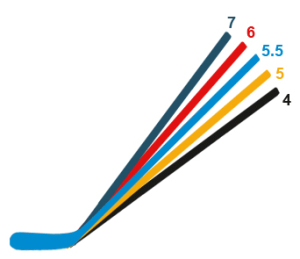
Stick Weight
All sticks are different, all-of-them. It's going to be hard to tell between a 410 and 417 gram stick without holding it in your hand. Some players prefer a heavier stick, especially those who load up on slapshots more often. The heavier the stick, potentially the more power you get. It also adds to the "feel" of the puck with stick handling. As you get more experience, going to a lighter stick will be easier. Or you can do what most do, buy the lightest thing out there just because...
Many players have switched to composites and that's what is being pushed now. As a new player, the heavier the stick will produce a better feel for the puck, your shot and stick handling. Try it, wood sticks are cheap, experience what hockey was like the past before you hit "The Future".
Stick Blade Patterns / Curve
The curve of the stick is how the blade curves from the heel to the toe of the stick. I generally see players start with a deeper curve than needed because, you know, their favorite player does. I like to see a player use as straight as a curve as possible, it gives them the ability to learn shooting and stick handling and grow their preference.
It really doesn't matter in the end the curve, your going to learn how to shoot with whatever curve you have. I like to see straight curves on my stick, they tend to be more versatile to me that ones with deeper curves.. the backhand is not going to backhand itself..
Stick Kick Point
Kick point is the location on the stick where the flex occurs. There are two kinds of kick points;
Low - The flex occurs closer to the blade. Generally for quicker shots like wrist and snap shots. The drawback is not as much power as a mid kick.
Mid - The flex occurs closer to the middle of the shaft. Generally for slapshots or hard wrist shots. The drawback is that more time is needed to get full power.
There are many NHLer's that utilize a kick point that doesn't fit their position. I believe this goes back to the years of experience and familiarity they have with their specific type of stick, they like it so why change? The big advantage to any specific kick point is to understand the type of player you are. If you prefer or always get picked for defence, then a mid might be best, however if your in a no slapshot league it might be better for a low kick point (Unless, like in your league, the opposing wingers never cover you and you have the time to take a hard shot).
Here are visual examples of kick point.
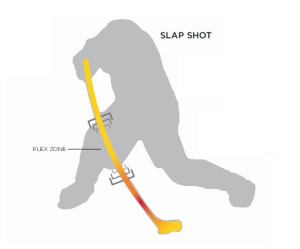
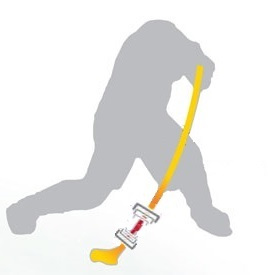
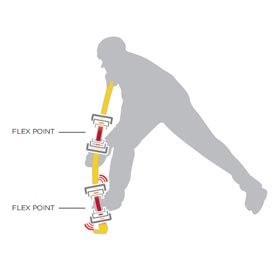
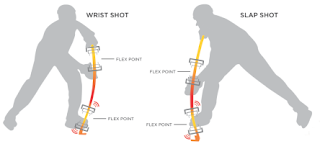
Stick Grip, Clear or Half and Half
The coating on the outside of sticks consist of:
- Grip - The outside consists of a material that is either "sticky" or "coarse" so the players hand does not slide.
- Clear - The outside consists of a material that is "slick" or "smooth" so a players hand does slide
- Half and Half - Reebok had made a stick that had grip on the underside of the stick where the top was clear. I also see some sticks with grip like "wrap". These sticks tend to be called grip but I am putting them in a separate category. I had one of these sticks even though I prefer clear, so it was a unique situation until it broke on me :( .
When I talk to players or look in the stores, I feel there is a good mixture of sticks that have grip or clear. I like having the ability to move my hand around without having to completely let go. For new players, the grip will help with hand placement. Beyond this, it's all about personal preference. Go back to "The Feel" section to review what you are and aren't supposed to do with your stick.
Stick Materials (Is that made of trees still?)
Hockey sticks are now made of the following materials, listed in order of "Too Freakin Heavy" to "Light as a Post-it".
- Wood
- Wood and Fiberglass
- Carbon and Fiberglass
- Graphite
- Kevlar
The better the material used in the stick, the more expensive, lighter and "better" the stick is. Trust me, the engineers and NHLer's that make these sticks, they do this for a good reason, money.. no, sorry, to make us better players.
There isn't a best recommendation on materials. Most of the manufacturers test these sticks out in the factory for breaks and best case usage. I would check reviews when possible to see if users post how long the stick lasts. The duration of the stick is likely the best indicator in this case.
And if your playing on an outdoor rink, some say to use wood, to me it wouldn't really matter. I believe it's because they are cheaper, but that doesn't mean they will last as long. Many manufacturers have added materials to composites to provide a better feel for the puck so wood is not always the best choice. If you are a younger player, wood might be best just because of the constant change in stick size. If you want to spend the money, go out and buy a composite.. your friends will be jealous.
What I call, "The Feel"
Go to your local store and pick it up, use it, bring your gloves and hold it, shoot with it (if possible), stick handle, lift it over your head, hell, take it to bed if you have to. Your going to be holding this thing for hours upon hours of your life every week, it might as well be something you like. And we can use the tire analogy, even if your car is a piece of crap, you can buy nice tires and have a great connection to the road.. er, puck.
That doesn't mean as a new player you should go buy the fanciest stick you can buy (why not make ones made of gold, I mean, they have iPhones now with gold on them). Really try to understand what your doing with this, if your playing multiple times a week a fancy composite will get you the most bang for your buck due to how long it will last and great it may feel. If you are just a pond hockey person, a wood stick will do just fine.
Shooting analysis goes a long way when it comes to your stick. Adding another shamless plug for Base Hockey. Get your own customized stick, you can't go wrong with that.
If you don't get a chance to try out the stick you like, ask a friend or someone in your league to borrow for a game or take a few shots with it. Real experience with a beauty of a stick will go a long way in choosing the right one.
Good luck on your choice!
